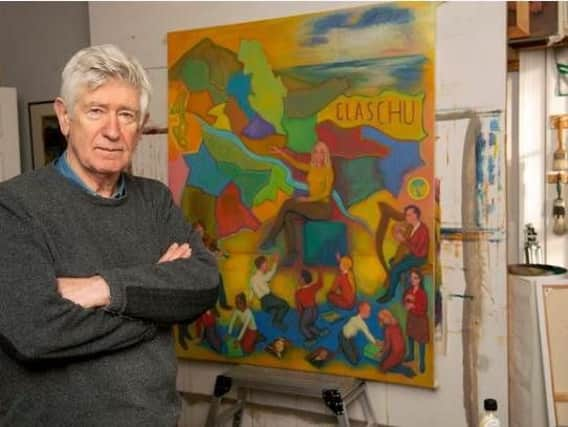Glasgow mod artist reveals new Gaelic-inspired painting


The distinguished painter Alexander “Sandy” Moffat – who was artist-in-residence to the Royal National Mòd 2019 – has created an colourful masterpiece to represent the vibrant health of the Scottish culture in the city.
The painting was commissioned by Glasgow Life in partnership with the University of Glasgow and The Hunterian, to celebrate the Mòd’s return to Clydeside for the first time since 1990.
Advertisement
Hide AdAdvertisement
Hide AdAs an artist in residence in the city during the October Mod festival, Sandy Moffat OBE RSA threw himself into the event learning about the ongoing traditions of Gaelic culture in Glasgow.
He then painted a 6ft x 5ft canvas full of references to what he had learnt and other Gaelic traditions from all over Scotland.
Speaking about his Mòd commission, Sandy Moffat said: “There were two starting points. The first was a dish towel I bought at the Glasgow Royal Concert Hall during the Mòd. The design was based on a medieval map dating from when Glasgow was primarily Gaelic-speaking, showing the Gaelic place names for all the districts of the city.
“The second influence was Gaelic education. After the Mòd finished, I visited the Glasgow Gaelic School in Berkeley Street, and was really impressed by the whole atmosphere of the school.”
Moffat said he was inspired by the children's grasp of the language and the creative feel to the school.
“It was a blaze of colour,” he said when referencing the artwork created by the children, the school decor and the pupils' bright red jumpers.
“It was like walking into a Matisse painting,” he said.
The inspiration is evident in his work with his choice of bright colours.
He is known for helping revive figurative painting in the city by inspiring future greats such as Peter Howson, Alison Watt and Ken Currie.
Advertisement
Hide AdAdvertisement
Hide AdCouncillor David McDonald, Depute Leader of Glasgow City Council and Chair of Glasgow Life says: “It will be fascinating to find out how the 2019 Mòd, and Gaelic culture in Glasgow has been depicted by an artist as renowned as Sandy Moffat, whose work has motivated generations of artists. I’m sure this wonderful new painting will be a real celebration of Glasgow’s proud Gaelic roots and an inspiration to our growing, youthful, vibrant community of Glaswegian Gaels.”
Professor Roibeard Ó Maolalaigh, Professor of Gaelic, Vice-Principal and Head of the College of Arts at the University of Glasgow, says: “Sandy Moffat’s colourful painting artfully captures both aspects of the past and future of Gaelic in the environs of Glasgow, its deep historical roots as well as the hopes for the future. The University of Glasgow is at the forefront of Gaelic research, development and education supporting the growing numbers of Gaelic learners as well as Scotland’s traditional Gaelic communities. We were delighted to support this creative work showcasing the vibrancy of Gaelic in Glasgow.”
The new painting also makes reference to William McTaggart’s famous painting, The Sailing Of The Emigrant Ship, which reflected on the draining away of the Highlands and Hebrides population during the Highland Clearances.
While Moffat said his time as an artist in residence left him feel “very optimistic about the future of Gaelic in Glasgow”, he is aware there are still challenges for the city.
The Royal National Mòd, Scotland’s premier Gaelic cultural festival, took place in Glasgow from October 11-19, 2019.
Before that, it had last been held in Glasgow in 1990, during its year as European City of Culture.
Three decades later, Gaelic – which has been spoken in the city for centuries – is on the up. Glasgow is currently home to the largest number of Gaelic speakers outwith the Highlands and Islands.